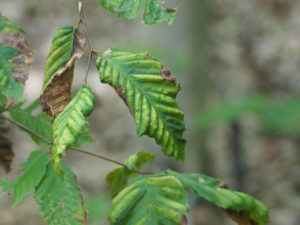What Is the Threat
Beech Leaf Disease, or BLD, affects the leaf tissue of beech trees. This is a relatively new plant disease and one that researchers are still examining. Currently, it’s believed that a species of nematode, called Litylenchus crenatae n. sp., might be directly involved.
This nematode was first discovered infecting beech trees in Japan, and the symptoms and patterns of the disease mimic those found in the forested areas of Eastern North America and Canada. In addition, certain microbial pathogens, which could be related to common foliar nematodes, could also be involved.
When these nematodes invade a beech tree, they infest its leaf tissue. The causes dark green bands to form between the leaf’s veins. The most extensive damage appears to occur while the leaf is still formed into a bud. This discoloration can lead to textural changes in the leaf, as well as curling and premature leaf drop.
Where Is the Threat
American Beech, Oriental Beech, and European Beech trees in southern Maryland are susceptible to Beech Leaf Disease. Researchers have noted some degree of variability in susceptibility among these species, but all have been known to host the offending intruders.
The first known instance of this disease in the United States occurred in Lake County, Ohio, in 2012. Since then, it’s been identified in around 40 different counties across the U.S. and Canada.
In addition to our state, this disease is also prevalent in Ohio, Pennsylvania, Connecticut, New York, and Ontario. Some researchers believe that the nematodes are traveling short distances via wingless insects, such as spider mites. It’s possible that they are also traveling long distances after being picked up by birds.
Symptoms of Beech Leaf Disease
If a tree is affected by Beech Leaf Disease, then the first symptom will be the appearance of dark green bands between the lateral veins of the tree’s leaves. The leaves may also appear smaller in size. In time, the striped leaf areas can take on a leathery texture, which can catalyze leaf curling and premature leaf drop.
If left untreated, the symptoms will progress. A severe case of Beech Leaf Disease can kill newly-formed buds, as well as reduce overall leaf production. This can ultimately reduce the size of the tree’s canopy cover.
For sapling-sized beech trees, these symptoms could cause total tree death within two to five years. For larger beech trees, that timeline is closer to six years. Note that this is a fast-spreading disease, and can affect up to 90% of the tree population in an area where it’s established.
What to Do About The Problem
If you suspect that your beech tree has fallen victim to Beech Leaf Disease, do not move it from its current location. If you live in or around Charles, St. Mary’s, Anne Arundel, or Calvert County, then contact our team for prompt treatment.
We can recommend products and solutions with proven nematicidal properties. These can help reduce the number of nematodes on your tree, which can slow or stop the symptoms.
NEED HELP?
If you live in Southern Maryland, or Northern Virginia
FIND YOUR SOLUTION HERE
People, Pet & Pollinator Safe! Pest control for people who care.
